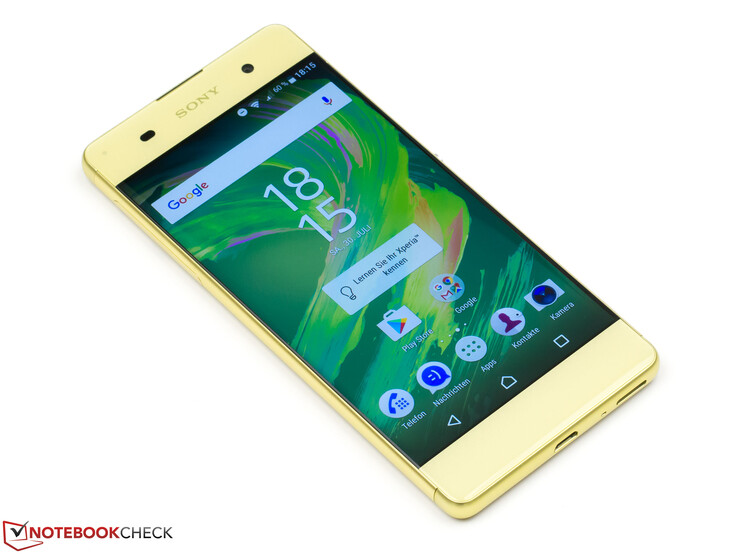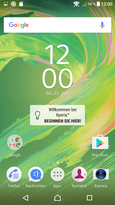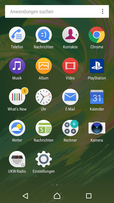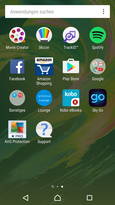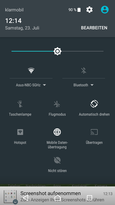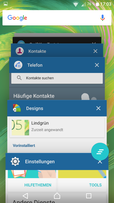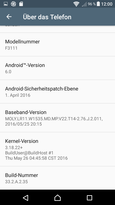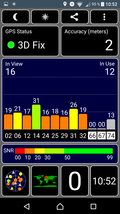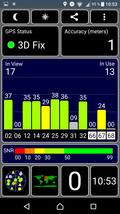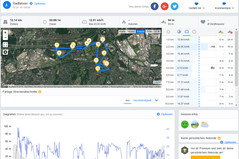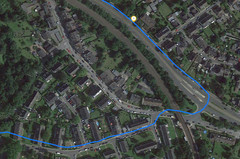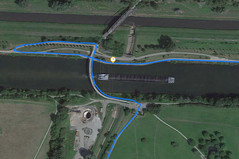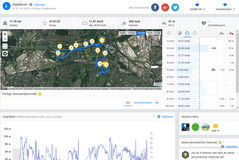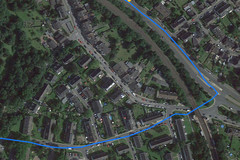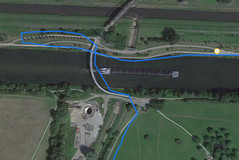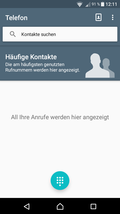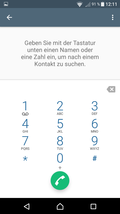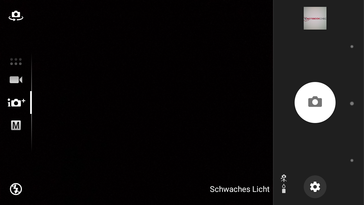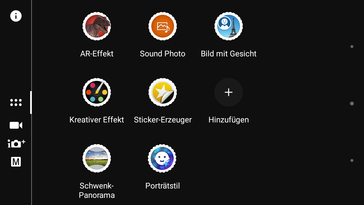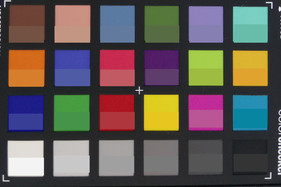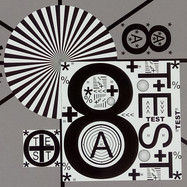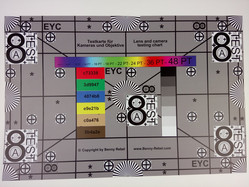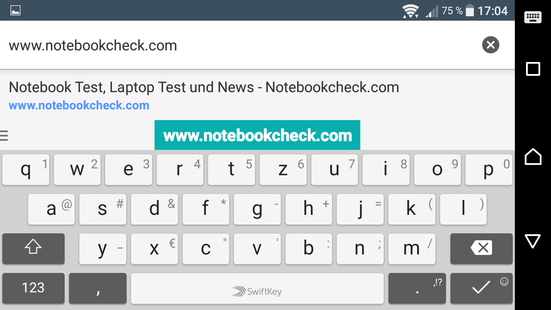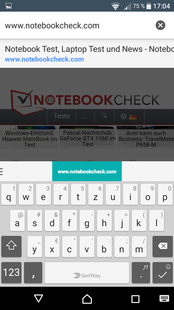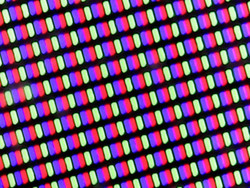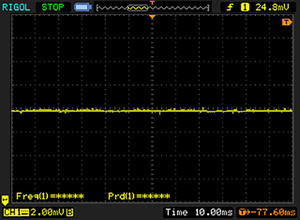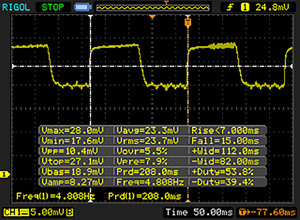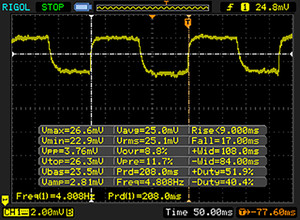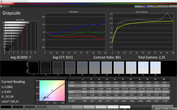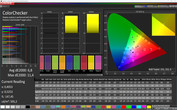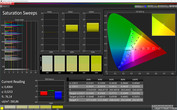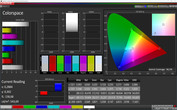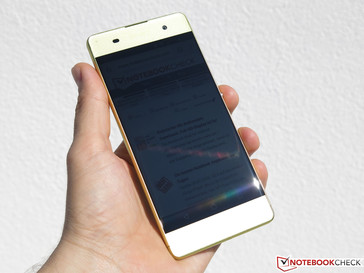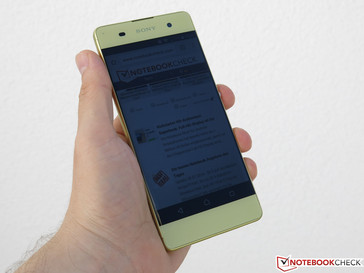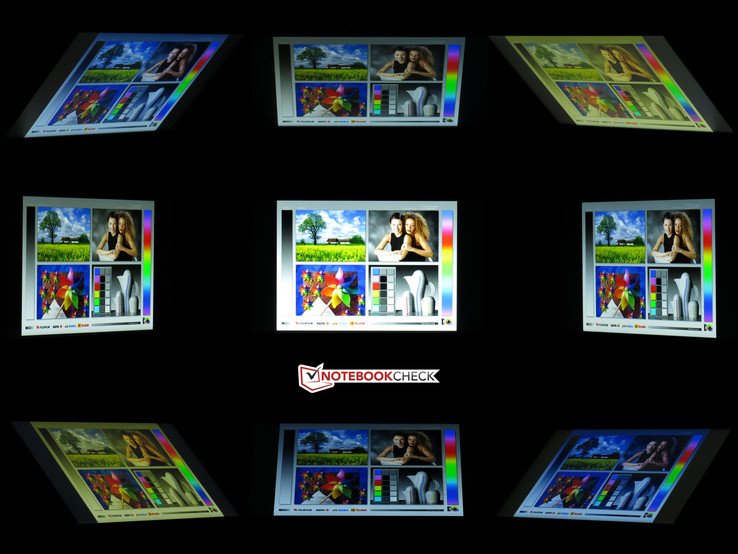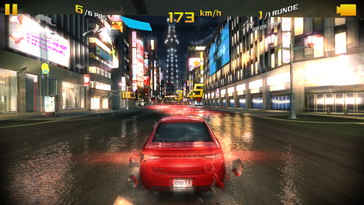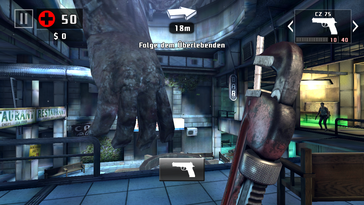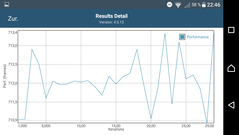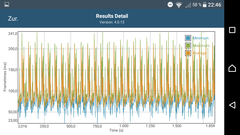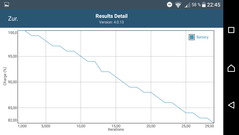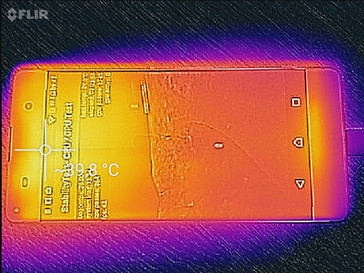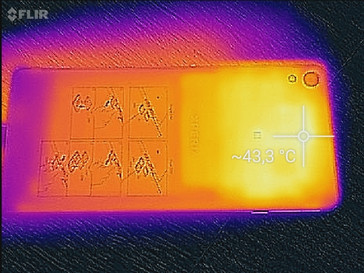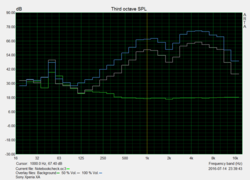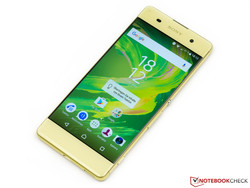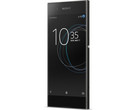Sony Xperia XA Smartphone Review
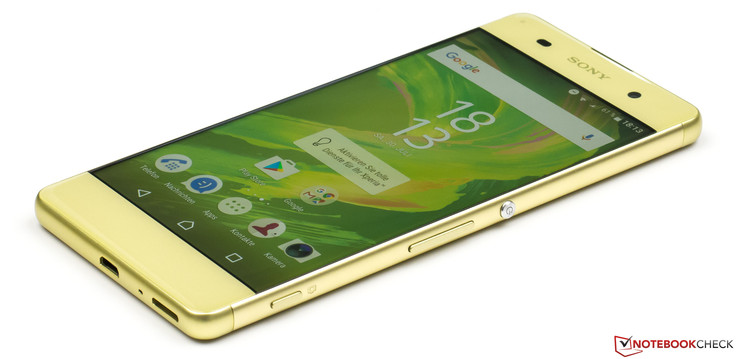
For the original German review, see here.
Sony's mid-range Xperia XA model is one of the manufacturer's new X-line, and a starting price of 300 Euros (~$335; market prices start at approx. 270 Euros/~$302) places it between the Xperia X, which is based on stronger components and the much cheaper Xperia E5 entry-level model. In addition to the color "Lime Gold" that adorns our review sample, the smartphone is also available in "Rose Gold", "Graphite Black", and "White". They all come with an octa-core SoC by MediaTek, 2 GB of RAM, and 16 GB of internal storage. The device is powered by Android 6.0 Marshmallow ex-factory.
Huawei's P9 Lite, ZTE's Blade V7, and Samsung's J5 (2016) and A3 (2016) models are the hottest rivals of the Xperia XA. Non-Android based opponents are rare in this price range, and thus Microsoft's Lumia 650, already available with a price tag starting at 170 Euros (~$190) has to prove its capabilities.
Case
As mentioned in the introduction, the casing of the Xperia XA primarily catches the attention with its particularly slim design. It has a width of just 66.8 millimeters (~2.6 in) to which the very narrow display bezel of less than one millimeter contributes. By comparison: Microsoft's Lumia 650, also equipped with a 5-inch screen, is 4.1 millimeters (~0.2 in) wider. The touchscreen's seamless transition into the lateral frame also looks well-implemented. However, the review sample does not stand out from its rivals favorably in terms of the other dimensions, and some users might consider it rather too long due to its unusual proportions. Sony primarily relies on plastic for the casing's material; metal is only used on the bezel's long lateral edges. This combination makes a relatively low weight of 137 grams (~5 oz) possible.
With its evenly spaced gaps and rounded surfaces on the front and rear, the smartphone is pleasant to hold and leaves a high-quality impression. At most, the slightly rough transition between the glass and metal on the touchscreen's sides in some places could be criticized. It is also too bad that the first hairline scratches on both the screen and smartphone's back were visible at the end of the test - using a somewhat more robust material would certainly not have hurt the looks in the long run.
The construction proved quite stable and our twisting attempts did not cause any major deformations or disconcerting noises. Nevertheless, it is too bad that light pressure on the display bezel causes wave formations on the screen quite easily. The maintenance options are limited to replacing the SIM and micro-SD card; the battery is non-removable.
Connectivity
The smartphone has a 16 GB flash storage for photos, apps, and such. However, with roughly 8.4 GB available capacity, only about half of it can be used in the state of delivery - the rivals often have a bit more to offer despite a nominally identical storage capacity. It is also possible to expand the Xperia XA by up to 200 GB. This is not a full-fledged replacement as the memory card cannot be implemented in the internal storage. At least files, such as photos and videos, and App2SD-supporting programs can be moved to it. A traditional 3.5-mm headset jack is installed for audio output. Data sharing is possible via a conventional micro-USB port with OTG functionality.
In addition, the smartphone supports video transmission via Miracast and media streaming via DLNA. NFC and a notification LED are also on board. The Xperia XA buyer will not find a fingerprint scanner, such as found in Huawei's P9 Lite.
Software
Sony ships the new model with Android 6.0 ex-factory. However, it is too bad that the manufacturer is rather slow with updates - the security patch from April 1st 2016 was still installed after looking for updates.
Sony has modified the Android user interface carefully and added some convenient features. These are mainly visual modifications to the graphic elements such as icons and backgrounds. The user still has to scroll vertically through the app drawer.
As well as typical Sony apps (Xperia Lounge, Playstation, What's New, Movie Creator, Sketch, TrackID), Sony has unfortunately preloaded several third-party programs such as Amazon Shopping, Facebook, Kobo eBooks, AVG Protection, Sky Go, and Spotify. Although they can all be deactivated, they cannot be uninstalled.
Communication & GPS
As well as the standard GSM and UMTS frequencies, the Xperia XA's mobile network modem also supports LTE Cat. 4 with up to 150 Mbit/s in download and 50 Mbit/s in upload. The handset can connect to both 2.4 and 5 GHz networks via Wi-Fi. However, the latest ac-standard is absent. In the speed test with our Linksys EA8500 reference router, the smartphone clearly outperforms cheaper handsets without 5 GHz Wi-Fi, such as Wiko's Lenny 3 or Honor's 5C, with gross data rates of 92.5 Mbit/s and 83.6 Mbit/s. It is, however, far from its more expensive Xperia X sister model or premium smartphones from Huawei or Samsung. Furthermore, our review sample supports data transfer via Bluetooth 4.1 and NFC for near-field communication.
| Networking | |
| iperf Server (receive) TCP 1 m | |
| Samsung Galaxy S7 Edge | |
| Huawei P9 | |
| Sony Xperia X | |
| Sony Xperia XA | |
| Honor 5C | |
| Wiko Lenny 3 | |
| iperf Client (transmit) TCP 1 m | |
| Samsung Galaxy S7 Edge | |
| Sony Xperia X | |
| Huawei P9 | |
| Sony Xperia XA | |
| Honor 5C | |
| Wiko Lenny 3 | |
The GPS module in the Xperia XA quickly finds the user's current position outdoors and in many cases connecting to satellite networks also functioned smoothly in the indoors. According to the app, the Xperia XA has an accuracy of up to a meter (3 ft) - an outstanding outcome. Our test route where we let the smartphone compete against Garmin's Edge 500 bike computer reveals whether this has a positive impact in practical situations. The Xperia XA is slightly disappointing after the initially very good rates with a total deviation of almost 3% in length and a rather rough logging of the driven route - particularly in the area of the turning point. Nevertheless, the actual performance should be more than sufficient for normal navigation purposes.
Telephone & Call Quality
Sony still relies on the familiar app from its Z-line for phone functionality. Many features are found on the main page, such as a search box for contacts, call list, and an overview of frequently called numbers. A keypad and address book can be accessed directly via faded-in icons.
The sufficient volume and clear voices at both ends of the call were good, when making calls using the earpiece. However, a quiet and not really annoying noise was sometimes audible. Using the headset for making calls also functioned very well. The tide turns when using hands-free mode: Both the speaker that is only sufficiently loud in quiet environments and the tinny-sounding microphone with too quiet voice recording prevented a relaxed conversation with the contact.
Cameras
The primary camera in Sony's Xperia XA has a category-standard resolution of 13 megapixels. It has also been equipped to a hybrid autofocus that makes it possible to take snapshots very quickly. An 8-megapixel webcam is installed on the front, which - uncharacteristically - also has autofocus. Both cameras have an aperture of f/2.0 and record videos with a maximum of Full HD at 30 frames per second.
While we liked the primary camera's fast autofocus and physical release button, the photo quality does not stand out significantly from other mid-range opponents: Firstly, some photos look unusually pale (scene 1), and secondly, grass and leaves often merge into green pulp (scene 2). Unfortunately, the review sample does not really shine in low-light conditions, although Sony boasts with "stunning low-light shots" (scene 3). The combination of strong noise cancellation and the absence of an optical image stabilizer is probably the reason for this. Premium models, such as Samsung's Galaxy S7 Edge or OnePlus' 3, produce sharper photos across the board. However, the achieved quality is still acceptable for a mid-range handset. We also noticed that slightly more than 10 centimeters (~4 in) of distance to the object is needed for macro photos than with many other smartphones.
The selfie camera on the front made a good impression. Thanks to its autofocus, it produces a nice depth of field in selfies, but it can also shoot comparatively sharp landscape photos when desired (see comparison photo).
Videos recorded with both cameras look smooth thanks to 30 frames per second. However, the brightness differences in panning shots are quite harsh and the simultaneous audio recording sounds rather muffled. Furthermore, the primary camera's autofocus is unreliable as it refocuses after movements - often unnecessarily. On the other hand, the optional electronic image stabilizer "SteadyShot" that can be activated, functions efficiently, but its use involves a slightly tighter camera viewing angle.
In addition to automatic, the camera app offers a manual mode where the user can set the ISO rate and white balance. Furthermore, scene modes, such as night shots or animals, can be found here. Panoramas can be created via the "Camera Apps" mode that provides additional functions. The quality of the panorama shots is not satisfactory due to numerous image errors (see sample photo).
We test whether the primary camera in the Xperia XA reproduces colors accurately by taking a photo of X-Rite's ColorChecker Passport in controlled light conditions and compare it with the actual reference colors. The photo is not edited afterward, for example, via manual white balance.
It is clearly visible that the reproduction of most colors is too saturated, which is particularly true for red tones. Furthermore, a slight underexposure becomes obvious in the photo when looking at the grayscale levels' brightness.
Blurred details that are sometimes seen in our sample photos are not observed when photographing our test chart in defined artificial light. The camera does a very good job here and hardly presents weaknesses for a mid-range handset. Only a slight decrease in sharpness is evident toward the corners. Many mid-range rivals, such as Samsung's Galaxy J5 (2016), do a worse job here.
Accessories & Warranty
In addition to the smartphone, the buyer will find an in-ear headset that, unlike many headphones nowadays, is not inserted directly into the ear canal, but rather sits on the ear cup in the box of the Xperia XA. Furthermore, a 7.5-watt power supply (1.5 A/5V) alongside a micro-USB cable and quick start guide are included. Sony lists various covers, a docking station, and a quick charger that supports MediaTek's Pump Express+ 2.0 as matching original accessories. Unfortunately, the latter was not available at the time of testing.
Sony includes a 2-year warranty on the smartphone and a 1-year warranty on included accessories in Germany, Austria, and Switzerland.
Input Devices & Handling
Sony has preloaded the keyboard solution "SwiftKey" on the Xperia XA. Both its looks and functionality can be adapted extensively to meet the user's needs. It is also possible to enter text via swipe.
The physical keys on the casing's right can be discerned well, thanks to their different shapes. It is also good that the camera has a dedicated button, which also launches the photo app in standby when pressed slightly longer. The build is solid, but the pressure point of the relatively sticky volume control was rather spongy in our review sample.
Unfortunately, the touchscreen in the review sample had recurrent problems. Sometimes it did not detect inputs correctly for no obvious reason, making it impossible, for example, to open quick settings or notifications via swipe. This phenomenon was also observed when browsing, in the form of a shaky implementation of zoom gestures. However, the touchscreen always recovered after a short break and functioned impeccably and accurately for a while. On the other hand, the integrated position sensor always rotated the content according to the smartphone's position quite reliably.
Although slight hiccups were perceived when scrolling slowly through menus or websites, this does not apply to the subjective total performance. Other animations are rendered smoothly in routine use, and the smartphone did not present any unusually prolonged waiting times. It is, however, too bad that the screen in the Xperia XA cannot be activated from standby via double tapping. The power button on the side has to be used for this.
Display
The Xperia XA is equipped with a 5-inch LC display with a resolution of 1280x720 pixels. This equates to a pixel density of 294 PPI. Although some rivalling models, such as Huawei's P9 Lite or ZTE's Blade V7, boast with an even higher resolution in this price range, pixel structures are not visible in the Xperia XA at a normal viewing distance.
Sony's smartphone places itself at the top with an average brightness of 475 cd/m² on a completely white screen – only Huawei's P9 Lite can offer a similarly bright screen among the opponents. The maximum brightness does not change significantly when displaying equally distributed bright and dark areas on the screen (average picture level/APL 50). However, this increases to a maximum of 572 cd/m² when the review sample's light sensor is enabled. The somewhat uneven illumination of 81% is not as good. With a contrast of 849:1, the Xperia XA places itself right between Huawei's P9 Lite and ZTE's Blade V7, also with an IPS panel. The relatively high contrast of 0.61 cd/m² prevents achieving a better contrast, despite the high maximum brightness. On the positive side, there is hardly any visible clouding on the review sample's screen even in unfavorable conditions.
The smartphone behaved strangely as soon as the minimum screen brightness was selected manually. Despite this setting, the backlight's intensity fluctuated slightly depending on the displayed content.
| |||||||||||||||||||||||||
Brightness Distribution: 81 %
Center on Battery: 518 cd/m²
Contrast: 849:1 (Black: 0.61 cd/m²)
ΔE ColorChecker Calman: 6.8 | ∀{0.5-29.43 Ø4.77}
ΔE Greyscale Calman: 7 | ∀{0.09-98 Ø5}
Gamma: 2.35
CCT: 8151 K
| Sony Xperia XA IPS, 1280x720, 5" | Samsung Galaxy J5 2016 AMOLED, 1280x720, 5.2" | Samsung Galaxy A3 2016 Super AMOLED, 1280x720, 4.7" | Huawei P9 Lite IPS, 1920x1080, 5.2" | ZTE Blade V7 IPS, 1920x1080, 5.2" | Microsoft Lumia 650 OLED, 1280x720, 5" | |
|---|---|---|---|---|---|---|
| Screen | 10% | 34% | 10% | -14% | 20% | |
| Brightness middle (cd/m²) | 518 | 289 -44% | 386 -25% | 505 -3% | 409 -21% | 349 -33% |
| Brightness (cd/m²) | 475 | 291 -39% | 394 -17% | 468 -1% | 411 -13% | 353 -26% |
| Brightness Distribution (%) | 81 | 96 19% | 88 9% | 88 9% | 96 19% | 92 14% |
| Black Level * (cd/m²) | 0.61 | 0.74 -21% | 0.38 38% | |||
| Contrast (:1) | 849 | 682 -20% | 1076 27% | |||
| Colorchecker dE 2000 * | 6.8 | 4.7 31% | 1.11 84% | 4.1 40% | 9.4 -38% | 2.6 62% |
| Colorchecker dE 2000 max. * | 11.4 | 7.3 36% | 3.35 71% | 5.8 49% | 17.6 -54% | 8.2 28% |
| Greyscale dE 2000 * | 7 | 3 57% | 1.34 81% | 4.9 30% | 11.6 -66% | 1.8 74% |
| Gamma | 2.35 94% | 2.03 108% | 2.12 104% | 2.5 88% | 2.25 98% | 2.06 107% |
| CCT | 8151 80% | 6291 103% | 6441 101% | 7116 91% | 9597 68% | 6542 99% |
* ... smaller is better
Screen Flickering / PWM (Pulse-Width Modulation)
| Screen flickering / PWM not detected | |||
In comparison: 53 % of all tested devices do not use PWM to dim the display. If PWM was detected, an average of 8084 (minimum: 5 - maximum: 343500) Hz was measured. | |||
Display Response Times
| ↔ Response Time Black to White | ||
|---|---|---|
| 22 ms ... rise ↗ and fall ↘ combined | ↗ 7 ms rise | |
| ↘ 15 ms fall | ||
| The screen shows good response rates in our tests, but may be too slow for competitive gamers. In comparison, all tested devices range from 0.1 (minimum) to 240 (maximum) ms. » 47 % of all devices are better. This means that the measured response time is similar to the average of all tested devices (20.2 ms). | ||
| ↔ Response Time 50% Grey to 80% Grey | ||
| 26 ms ... rise ↗ and fall ↘ combined | ↗ 9 ms rise | |
| ↘ 17 ms fall | ||
| The screen shows relatively slow response rates in our tests and may be too slow for gamers. In comparison, all tested devices range from 0.165 (minimum) to 636 (maximum) ms. » 35 % of all devices are better. This means that the measured response time is better than the average of all tested devices (31.6 ms). | ||
The Xperia XA offers some options for customizing the color reproduction. The user can enable an image optimizer via either "Bravia Engine 2" or "Super-Vivid Mode", or the white balance can be adapted cross-system via a slider. The color temperature of 8151 K is clearly higher than the ideal rate of 6500 K when using Bravia Engine and default white balance, which becomes visible in a bluish tint in the grayscale levels. The color deviations of the Xperia XA are also much higher than the ideal range (less than 3) with DeltaE rates of 6.8 (colors) and 7 (grayscale). Almost all rivaling models present a better calibration; only ZTE's Blade V7 steps out of line with much larger aberrations here. Subjectively, the measured inaccuracies are not noticed in everyday use.
Overall, the Xperia XA is quite suitable for outdoor use, thanks to its relatively high brightness. However, a shaded place is recommended in cases of direct sunlight or stronger reflections since only high-contrast image areas can then still be recognized.
In terms of viewing angle stability, the Xperia XA proves to be much weaker than its more expensive Xperia X sister model and rivals equipped with OLED panels. Although thanks to the IPS technology the image never inverts, the user has to live with clear changes in color tones and brightness decrease in flatter viewing angles.
Performance
Unlike Sony's more expensive Xperia X, a Qualcomm SoC is not installed in the Xperia XA but rather a processor from MediaTek. The Helio P10 chip consists of 8 ARM Cortex A53 cores that clock at a maximum of 2 GHz. An ARM Mali-T860 MP2 graphics unit is present. The working memory of 2 GB is average compared with the Android opponents: While Samsung's Galaxy A3 (2016) offers only 1.5 GB, Huawei's P9 Lite can shine with a generous 3 GB.
As a SoC from the upper mid-range, the Helio P10 gives a superb performance and makes the Xperia XA look very good compared with most rivals. Only Huawei's P9 Lite delivers somewhat better scores in the AnTuTu, PCMark, and BaseMark benchmarks. Sony’s choice of a lower resolution HD panel pays off in the GFXBench and 3DMark graphic tests. Although the Huawei P9 Lite’s Full HD screen is often slightly better in the offscreen tests, it loses its lead as soon as an image is really rendered. Consequently, the review sample takes the benchmark crown in this subfield.
| AnTuTu v6 - Total Score (sort by value) | |
| Sony Xperia XA | |
| Samsung Galaxy J5 2016 | |
| Samsung Galaxy A3 2016 | |
| Huawei P9 Lite | |
| ZTE Blade V7 | |
| Microsoft Lumia 650 | |
| PCMark for Android - Work performance score (sort by value) | |
| Sony Xperia XA | |
| Samsung Galaxy J5 2016 | |
| Samsung Galaxy A3 2016 | |
| Huawei P9 Lite | |
| ZTE Blade V7 | |
| GFXBench (DX / GLBenchmark) 2.7 | |
| T-Rex Onscreen (sort by value) | |
| Sony Xperia XA | |
| Samsung Galaxy J5 2016 | |
| Samsung Galaxy A3 2016 | |
| Huawei P9 Lite | |
| ZTE Blade V7 | |
| Microsoft Lumia 650 | |
| 1920x1080 T-Rex Offscreen (sort by value) | |
| Sony Xperia XA | |
| Samsung Galaxy J5 2016 | |
| Samsung Galaxy A3 2016 | |
| Huawei P9 Lite | |
| ZTE Blade V7 | |
| Microsoft Lumia 650 | |
| GFXBench 3.0 | |
| 1920x1080 1080p Manhattan Offscreen (sort by value) | |
| Sony Xperia XA | |
| Samsung Galaxy J5 2016 | |
| Samsung Galaxy A3 2016 | |
| Huawei P9 Lite | |
| ZTE Blade V7 | |
| on screen Manhattan Onscreen OGL (sort by value) | |
| Sony Xperia XA | |
| Samsung Galaxy J5 2016 | |
| Samsung Galaxy A3 2016 | |
| Huawei P9 Lite | |
| ZTE Blade V7 | |
| GFXBench 3.1 | |
| 1920x1080 Manhattan ES 3.1 Offscreen (sort by value) | |
| Sony Xperia XA | |
| Samsung Galaxy J5 2016 | |
| Huawei P9 Lite | |
| ZTE Blade V7 | |
| on screen Manhattan ES 3.1 Onscreen (sort by value) | |
| Sony Xperia XA | |
| Samsung Galaxy J5 2016 | |
| Huawei P9 Lite | |
| ZTE Blade V7 | |
| GFXBench | |
| 1920x1080 Car Chase Offscreen (sort by value) | |
| Sony Xperia XA | |
| Samsung Galaxy J5 2016 | |
| Huawei P9 Lite | |
| on screen Car Chase Onscreen (sort by value) | |
| Sony Xperia XA | |
| Samsung Galaxy J5 2016 | |
| Huawei P9 Lite | |
| 3DMark | |
| 1280x720 offscreen Ice Storm Unlimited Score (sort by value) | |
| Sony Xperia XA | |
| Samsung Galaxy J5 2016 | |
| Samsung Galaxy A3 2016 | |
| Huawei P9 Lite | |
| ZTE Blade V7 | |
| 1280x720 offscreen Ice Storm Unlimited Graphics Score (sort by value) | |
| Sony Xperia XA | |
| Samsung Galaxy J5 2016 | |
| Samsung Galaxy A3 2016 | |
| Huawei P9 Lite | |
| ZTE Blade V7 | |
| 1280x720 offscreen Ice Storm Unlimited Physics (sort by value) | |
| Sony Xperia XA | |
| Samsung Galaxy J5 2016 | |
| Samsung Galaxy A3 2016 | |
| Huawei P9 Lite | |
| ZTE Blade V7 | |
| 2560x1440 Sling Shot OpenGL ES 3.0 Physics (sort by value) | |
| Sony Xperia XA | |
| Samsung Galaxy J5 2016 | |
| Samsung Galaxy A3 2016 | |
| Huawei P9 Lite | |
| ZTE Blade V7 | |
| 2560x1440 Sling Shot OpenGL ES 3.0 Graphics (sort by value) | |
| Sony Xperia XA | |
| Samsung Galaxy J5 2016 | |
| Samsung Galaxy A3 2016 | |
| Huawei P9 Lite | |
| ZTE Blade V7 | |
| 2560x1440 Sling Shot OpenGL ES 3.0 (sort by value) | |
| Sony Xperia XA | |
| Samsung Galaxy J5 2016 | |
| Samsung Galaxy A3 2016 | |
| Huawei P9 Lite | |
| ZTE Blade V7 | |
The familiar pecking order is seen again in the browser benchmarks: While the Xperia XA and P9 Lite are neck and neck at the forefront, the other comparison devices all lag behind.
| Mozilla Kraken 1.1 - Total (sort by value) | |
| Sony Xperia XA | |
| Samsung Galaxy J5 2016 | |
| Samsung Galaxy A3 2016 | |
| Huawei P9 Lite | |
| ZTE Blade V7 | |
| Microsoft Lumia 650 | |
| Octane V2 - Total Score (sort by value) | |
| Sony Xperia XA | |
| Samsung Galaxy J5 2016 | |
| Samsung Galaxy A3 2016 | |
| Huawei P9 Lite | |
| ZTE Blade V7 | |
| Microsoft Lumia 650 | |
| WebXPRT 2015 - Overall (sort by value) | |
| Sony Xperia XA | |
| Samsung Galaxy J5 2016 | |
| Samsung Galaxy A3 2016 | |
| Huawei P9 Lite | |
| Microsoft Lumia 650 | |
| JetStream 1.1 - Total Score (sort by value) | |
| Sony Xperia XA | |
| Samsung Galaxy J5 2016 | |
| Samsung Galaxy A3 2016 | |
| Huawei P9 Lite | |
| ZTE Blade V7 | |
* ... smaller is better
Although the 16 GB flash memory in the Xperia XA does not achieve a top ranking in Androbench 3 with its performance rates, a place in the midfield is always achieved when compared with the competition. The relatively fast sequential read speed of approximately 240 MB/s is particularly noticeable. Only Huawei's P9 Lite surpasses it here. However, there is still some elbowroom in random read processes: The Blade V7 and, again, the P9 Lite outrun the review sample. The outcome of the BaseMark OS II memory benchmark also fits in this picture: The Xperia XA takes the second place behind Huawei's P9 Lite.
It looks similarly solid with the memory card slot's interface. Using our Toshiba Exceria Pro M401 (THN-M401S0640E2, UHS-I Class 3, max. read: 95 MB/s, max. write: 80 MB/s) reference card, we determined the best write rate in the comparison field with 50.68 MB/s, and the read rate of 72.87 MB/s is also within reach of the leader, Samsung's Galaxy J5 (2016), - a superb performance.
| AndroBench 3-5 | |
| Random Read 4KB (sort by value) | |
| Sony Xperia XA | |
| Samsung Galaxy J5 2016 | |
| Samsung Galaxy A3 2016 | |
| Huawei P9 Lite | |
| ZTE Blade V7 | |
| Random Write 4KB (sort by value) | |
| Sony Xperia XA | |
| Samsung Galaxy J5 2016 | |
| Samsung Galaxy A3 2016 | |
| Huawei P9 Lite | |
| ZTE Blade V7 | |
| Sequential Write 256KB (sort by value) | |
| Sony Xperia XA | |
| Samsung Galaxy J5 2016 | |
| Samsung Galaxy A3 2016 | |
| Huawei P9 Lite | |
| ZTE Blade V7 | |
| Sequential Read 256KB (sort by value) | |
| Sony Xperia XA | |
| Samsung Galaxy J5 2016 | |
| Samsung Galaxy A3 2016 | |
| Huawei P9 Lite | |
| ZTE Blade V7 | |
| Sequential Write 256KB SDCard (sort by value) | |
| Sony Xperia XA | |
| Samsung Galaxy J5 2016 | |
| Huawei P9 Lite | |
| ZTE Blade V7 | |
| Sequential Read 256KB SDCard (sort by value) | |
| Sony Xperia XA | |
| Samsung Galaxy J5 2016 | |
| Huawei P9 Lite | |
| ZTE Blade V7 | |
| BaseMark OS II - Memory (sort by value) | |
| Sony Xperia XA | |
| Samsung Galaxy J5 2016 | |
| Samsung Galaxy A3 2016 | |
| Huawei P9 Lite | |
| ZTE Blade V7 | |
| Microsoft Lumia 650 | |
Games
As the previous benchmark scores have clearly proven, the Mali-T860 MP2 graphics chip in the Xperia XA together with the screen's moderate resolution of 1280x720 pixels ensure a fast performance. Thus, in practice, even demanding games such as "Asphalt 8" or "Dead Trigger 2" can be played smoothly using high-quality settings.
While the integrated position sensors function inconspicuously well during games, the very noticeable temperature increase on the handset's rear could be quite annoying. The speaker situated on the side will not normally be covered by a hand - and if so, the sound is almost inaudible.
| Asphalt 8: Airborne | |||
| Settings | Value | ||
| high | 27 fps | ||
| very low | 29 fps | ||
| Dead Trigger 2 | |||
| Settings | Value | ||
| high | 59 fps | ||
Emissions
System Noise
The smartphone itself is silent since it is cooled passively. However, we observed a relatively prominent coil whining from the included power supply that was still audible a few meters away in a quiet environment, particularly when the battery was fully charged.
Temperature
The surface temperatures of the Xperia XA prove that a slim casing and a relatively strong processor are not always a good team. While the average idle temperatures of 33.4 °C (~92 °F) on the front and 31.7 °C (~89 °F) on the back are still within a normal range, the smartphone heats up to over 40 °C (~104 °F) during load. Although this is not really hot, it could cause moist hands, especially in the summer. The rivals usually remain a few degrees cooler. Only the similarly powerful Huawei P9 Lite reaches a comparable top rate, that is, however, limited to spots.
It is, however, pleasing that the SoC does not throttle its clock speed due to the temperatures. The GFXBench battery test that performs the T-Rex test thirty times in succession and logs both the performance and battery consumption did not present any weaknesses here. The processing performance remains stable.
(±) The maximum temperature on the upper side is 42 °C / 108 F, compared to the average of 35.2 °C / 95 F, ranging from 21.9 to 247 °C for the class Smartphone.
(±) The bottom heats up to a maximum of 41.7 °C / 107 F, compared to the average of 34 °C / 93 F
(±) In idle usage, the average temperature for the upper side is 33.4 °C / 92 F, compared to the device average of 32.9 °C / 91 F.
Speaker
The Xperia XA's speaker is situated on the handset's lower edge, and thus the smartphone's sound is not impaired when placed on a table. However, the sound is almost completely inaudible when it is held in the hands and the small opening is covered accidentally. Furthermore, the maximum volume is quite low with at most 82.02 dB(A) in our Pink Noise test. This places the Xperia XA on one of the last places in our database compared with other smartphones. At the same time, the minimum volume is relatively high, resulting in a limited control range. The frequency response analysis clearly shows a clear deficiency in the medium-high tones and bass range. This results in a fairly thin sound subjectively that fortunately, does not become piercing and is mostly free of distortion.
The included headset is good, with a balanced sound. We did not observe any static via the 3.5-mm headset jack either.
Frequency diagram in comparison (check boxes above can be turned on/off!)
Rate 1: Pink Noise 100% volume; Rate 2: Audio off
Energy Management
Power Consumption
Our comparison chart shows that powerful hardware exhausts the power reserves quicker: The handsets from Samsung, Microsoft and ZTE, all equipped with somewhat weaker SoCs, almost always consume less power than the Xperia XA with its fast octa-core processor. Only the slightly faster Huawei's P9 Lite needs more energy on average than the review sample.
| Off / Standby | |
| Idle | |
| Load |
|
Key:
min: | |
| Sony Xperia XA 2300 mAh | Samsung Galaxy J5 2016 3100 mAh | Samsung Galaxy A3 2016 2300 mAh | Huawei P9 Lite 3000 mAh | ZTE Blade V7 2540 mAh | Microsoft Lumia 650 2000 mAh | |
|---|---|---|---|---|---|---|
| Power Consumption | 20% | 10% | -15% | 10% | 14% | |
| Idle Minimum * (Watt) | 0.72 | 0.61 15% | 0.96 -33% | 0.73 -1% | 0.73 -1% | 0.7 3% |
| Idle Average * (Watt) | 1.5 | 1.41 6% | 1.39 7% | 2.09 -39% | 0.92 39% | 1.1 27% |
| Idle Maximum * (Watt) | 1.57 | 1.51 4% | 1.45 8% | 2.11 -34% | 0.93 41% | 1.18 25% |
| Load Average * (Watt) | 3.48 | 2.56 26% | 2.65 24% | 4.15 -19% | 4.47 -28% | 4.04 -16% |
| Load Maximum * (Watt) | 6.04 | 3.1 49% | 3.51 42% | 5.05 16% | 5.96 1% | 4.07 33% |
* ... smaller is better
Battery Runtime
Due to the relatively high power consumption and comparatively small 2300 mAh battery, the Xperia XA does not have good preconditions in the race for the longest battery life. With 5 hours and 53 minutes in the practical Wi-Fi test, it clearly lags behind most opponents. The Galaxy A3 (2016) manages over four and a half hours longer here. Microsoft's Lumia 650 with an even smaller battery is only marginally inferior. Apart from this exception, the review sample takes the last place in all other tests.
Therefore, the Xperia XA's two energy-savings modes are particularly important. The normal "Stamina" mode that limits the handset's performance, background activities, and screen brightness, and also disables vibration feedback is the sensible choice for anyone who wants to use the smartphone as usual. This way, a few extra minutes of battery life could be retrieved from the handset in everyday use. However, this setting did not have an impact on our test of the maximum battery life. The "Ultra-Stamina" mode should result in a much longer battery life, but all online features are then disabled.
We discovered that the smartphone apparently has some emergency reserves in our runtime tests. At a battery state of 1%, it reproducibly remained active for approximately 6% of the total runtime. The Xperia XA supports the quick charging technology "Pump Express+ 2.0" for recharging the battery as fast as possible. However, the necessary charger, UCH12, is not included, and it was not available in any online stores at the time of testing. The included 7.5-watt power supply needed just under two hours for a complete recharge cycle; according to the display, 70% of the total capacity was reached after roughly one hour.
| Sony Xperia XA 2300 mAh | Samsung Galaxy J5 2016 3100 mAh | Samsung Galaxy A3 2016 2300 mAh | Huawei P9 Lite 3000 mAh | ZTE Blade V7 2540 mAh | Microsoft Lumia 650 2000 mAh | |
|---|---|---|---|---|---|---|
| Battery runtime | 93% | 112% | 59% | 47% | 14% | |
| Reader / Idle (h) | 12.9 | 26.7 107% | 33 156% | 23.4 81% | 15.2 18% | |
| H.264 (h) | 7.7 | 11 43% | 14.4 87% | 9.5 23% | 8.5 10% | |
| WiFi v1.3 (h) | 5.9 | 10.7 81% | 10.5 78% | 10.1 71% | 8.7 47% | 5.8 -2% |
| Load (h) | 2.8 | 6.7 139% | 6.3 125% | 4.5 61% | 3.6 29% |
Pros
Cons
Verdict
Sony's new Xperia XA mid-range smartphone reaps in some plus points with its good configuration: The 16 GB internal storage is easily expandable with a micro-SD card, the micro-USB port is OTG compatible, and NFC is also on board. However, a fingerprint scanner for unlocking the smartphone comfortably is absent. Photo enthusiasts will probably be pleased with the dedicated release button, and the primary camera's relatively high resolution and autofocus. As common in this category, compromises will have to be made in terms of image quality. We also liked the good performance of the installed MediaTek SoC and bright screen. The recurrent touchscreen issues, however, were annoying during the test. An absolute no-go for many potential buyers will probably be the below-average battery life.
The Xperia XA will primarily catch the attention with its slim line, but the inner values in the form of a fast SoC, bright screen, and expandable storage are also very convincing. It is ultimately the short battery life that ruins the review sample's otherwise decent outcome.
At a market price of approximately 270 Euros (~$302), the Xperia XA is situated within the upper price scale for current mid-range smartphones. Huawei's P9 Lite in particular has proved to be a worthy opponent in many aspects in the test. It offers some advantages with a larger screen, longer battery life and integrated fingerprint scanner, and it is also available for a starting price of approximately 270 Euros (~$302).
Sony Xperia XA
- 08/10/2016 v5.1 (old)
Andreas Kilian




